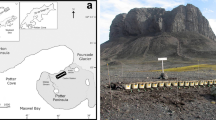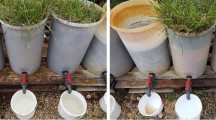Abstract
The natural attenuation of polyaromatic hydrocarbons (PAHs) in the vadose zone of a naturally revegetated former industrial sludge basin (0.45 ha) was examined. This was accomplished by comparing the concentration of 16 PAH contaminants present in sludge collected below the root zone of plants with contaminants present at 3 shallower depths within the root zone. Chemical analysis of 240 samples from 60 cores showed the average concentration of total and individual PAHs in the 0–30 cm, 30–60 cm, and bottom of the root zone strata were approximately 10, 20, and 50%, respectively, of the 16, 800 ppm average total PAH concentration in deep non-rooted sludge. Statistically significant differences in average PAH concentrations were observed between each strata studied and the non-rooted sludge except for the concentrations of acenaphthene and chrysene present at the bottom of the root zone in comparison to sludge values. The rooting depth of the vegetation growing in the basin was dependent on both vegetation type and plant age. Average rooting depths for trees, forbs (herbaceous non-grasses), and grasses were 90, 60, and 50 cm, respectively. The deepest root systems observed (100–120 cm) were associated with the oldest (12–14 year-old) mulberry trees. Examination of root systems and PAH concentrations at numerous locations and depths within the basin indicated that plant roots and their microbially active rhizospheres fostered PAH disappearance; including water insoluble, low volatility compounds, i.e. benzo(a)pyrene and benzo(ghi)perylene. The reduced concentration of PAHs in the upper strata of this revegetated former sludge basin indicated that natural attenuation had occurred. This observation supports the concept that through appropriate planting and management practices (phytoremediation) it will be possible to accelerate, maximize, and sustain natural processes, whereby even the most recalcitrant PAH contaminants (i.e. benzo(a)pyrene) can be remediated over time.
Similar content being viewed by others
References
Amann RI, Ludwig W, Schleifer KH (1995): Phylogenetic identification and in situ detection of individual microbial cells without cultivation. Microbial Reviews.59, 143–169
Brigmon RL, Anderson TA, Fliermans CB (1999): Methanotrophic bacteria in the rhizosphere of trichoroethylene-degrading plants. International Journal of Phytoremediation1, 241–253
Curl EA, Truelove B (1986): The Rhizosphere. Springer-Verlag. New York, pp 288
Donnelly PK, Hegde RS, Fletcher JS (1994): Growth of PCB-degrading bacteria on compounds from photosynthetic plants. Chemosphere28, 981–988
Donnelly PK, Fletcher JS (1995): PCB metabolism by mycroorhizal fungi. Bull Environ Contam Toxicol54, 507–513
Fletcher JS, Hegde RS (1995): Release of phenols by perennial plant roots and their potential importance in bioremediation. Chemosphere31, 3009–3016
Gaskin J, Fletcher JS (1997): Mineralization of exogenously supplied organic substrates by ponderosa pine roots with and without the ectomycorrhizal fungus Hebeloma crustuliniforme. American Chemical Society, Washington D.C., Symposium series664, 152–160
Kastner M, Lotter S, Heerenklage J, Breuer-Jammali M, Stegmann R, Mahro B (1995): Fate of14C-labeled anthracene and hexadecane in compostmanured soil. Appl. Microbiol. Biotechnology43, 1128–1135
Leeson A, Alleman BC (1999): Natural Attenuation of Chlorinated Solvents, Petroleum Hydrocarbons, and Other Organic Compounds. The Fifth International In Situ and On-Site Bioremediation Symposium. San Diego, CA. April 19–22, 1999. 5(1) ISBN 1-57477-074-8
Leigh MB (1997): Influence of season, age and senescence of the phenolic content of mulberry fine roots with reference to phytoremediation. MS Thesis, University of Oklahoma, Norman, OK
Mackay D, Shiu WY, Ma KC (1992): Illustrated Handbook of Physical-Chemical Properties and Environmental Fate for Organic Chemicals. Volume II: Polynuclear Aromatic Hydrocarbons, Polychlorinated Dioxins, and Dibenzofurans. Lewis Publishers. Chelsea, Michigan, pp 597
Nagle DP, Kyle MD, Olson PE, Fletcher JS (1998): Bacterial microflora from a vegetated, PAH-contaminated industrial site. Abstract. IBC Third International Conference on Phytoremediation: Strategies and Evaluation of Phytoremediation’s Performance in the Field. June 22–25, Houston, TX
Olson PE, Fletcher JS (1999): Field evaluation of mulberry root structure with regard to phytoremediation. Bioremediation Journal 3, 27–33
Olson PE, Fletcher JS (2000): Ecological recovery of vegetation at a former industrial sludge basin and its implications to phytoremediation and ecological risk assessment. ESPR — Environ Sci & Pollut Res 7 (4) 195–204
Siciliano SD, Germida JJ (1997): Bacterial inoculants of forage grasses that enhance degradation of 2-chlorobenzic acid in soil. Eviron Toxicol And Chem 16, 1098–1104
Siciliano SD, Germida JJ (1998): Mechanisms of phytoremediation: biochemical and ecological interactions between plants and bacteria. Environmental Reviews.6, 65–79
Tansley AG (1935): The use and abuse of vegetational concepts and terms. Ecology16, 284–307
USEPA (1986a): Method 3540. Soxhlet Extraction. SW-846: Test Methods for Evaluating Solid Waste (Physical/Chemical Methods). United States Environmental Protection Agency: Office of Solid Waste. Washington, D.C.
USEPA (1986b): Method 8100. Polynuclear Aromatic Hydrocarbons. SW-846: Test Method for Evaluating Solid Waste (Physical/Chemical Methods). United States Environmental Protection Agency: Office of Solid Waste. Washington, D.C.
Wiedemeier TH, Wilson JT, Kampbell DH, Miller RN, Hansen JE (1995): Technical protocol for implementing intrinsic remediation with longterm monitoring for natural attenuation of fuel contamination dissolved in groundwater. U.S. Air Force Center for Environmental Excellence. San Antonio, TX
Wiedemeier TH, Swanson MA, Moutoux DE, Gordon EK, Wilson JT, Wilson BH, Kampbell DH, Haas PE, Miller RN, Hansen JE, Chapelle FH (1998): Technical protocol for evaluating natural attenuation of chlorinated solvents in ground water. U.S. Environmental Protection Agency. Office of Research and Development. Washington, D.C.
Author information
Authors and Affiliations
Corresponding author
Rights and permissions
About this article
Cite this article
Olson, P.É., Flechter, J.S. & Philp, P.R. Natural attenuation/phytoremediation in the vadose zone of a former industrial sludge basin. Environ Sci & Pollut Res 8, 243–249 (2001). https://doi.org/10.1007/BF02987400
Received:
Accepted:
Issue Date:
DOI: https://doi.org/10.1007/BF02987400




